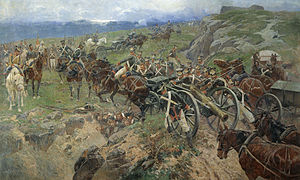Russo-Persian War (1804–1813)
| Russo Persian War (1804–1813) | |||||||||
|---|---|---|---|---|---|---|---|---|---|
| Part of the Russo-Persian Wars and the Napoleonic Wars |
|||||||||
 This painting by Franz Roubaud illustrates an episode near the Askerna river where the Russians managed to repel attacks by a larger Persian army for two weeks. They made a "living bridge", so that two cannons could be transported over their bodies. |
|||||||||
|
|||||||||
| Belligerents | |||||||||
|
|
|
||||||||
| Commanders and leaders | |||||||||
|
|
|
||||||||
| Strength | |||||||||
| 48,000 troops, 21,000 irregular cavalry | 50,000 Nezam-e Jadid (modern style infantry), 20,000 irregular cavalry, 25,000 other allied or old style Persian troops | ||||||||
The 1804–1813 Russo-Persian War, was one of the many wars between the Persian Empire and Imperial Russia, and began like many of their wars as a territorial dispute. The new Persian king, Fath Ali Shah Qajar, wanted to consolidate the northernmost reaches of his kingdom—modern day Georgia—which had been annexed by Tsar Paul I several years after the Russo-Persian War of 1796. Like his Persian counterpart, the Tsar Alexander I was also new to the throne and equally determined to control the disputed territories.
The war ended in 1813 with the Treaty of Gulistan which irrevocably ceded the previously disputed territory of Georgia to Imperial Russia, but added the Iranian territories of Dagestan, most of what is nowadays Azerbaijan, and minor parts of Armenia to it.
The origins of the first full scale Russo-Persian War can be traced back to the decision of Tsar Paul to annex Georgia (December 1800) after Erekle II, who had been appointed as ruler of Kartli several years earlier by his ruler Nader Shah, made a plea to Christian Russia in the Treaty of Georgievsk of 1783 to be incorporated into the empire. After Paul’s assassination (11 March 1801), the activist policy was continued by his successor, Tsar Alexander, aimed at establishing Russian control over the khanates of the eastern Caucasus. In 1803, the newly appointed commander of Russian forces in the Caucasus, Paul Tsitsianov, attacked Ganja and captured its citadel on 15 January 1804. Ganja's governor, Javad Khan Qajar, was killed, and a large number of the inhabitants slaughtered. The Qajar ruler, Fath Ali Shah, saw the Russian threat to Armenia, Karabagh, and Azerbaijan not only as a source of instability on his northwestern frontier but as a direct challenge to Qajar authority.
...
Wikipedia
